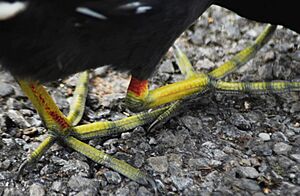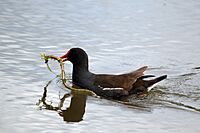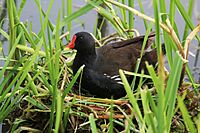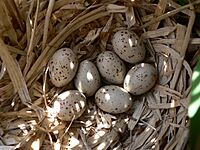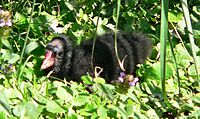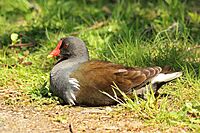Common moorhen facts for kids
Quick facts for kids Common moorhen |
|
|---|---|
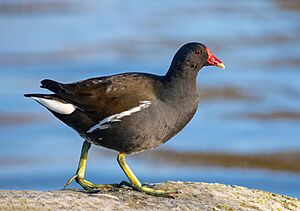 |
|
| Conservation status | |
| Scientific classification | |
| Genus: |
Gallinula
|
| Species: |
chloropus
|
| Subspecies | |
|
About five; see text |
|
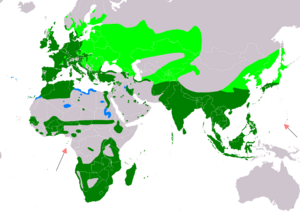 |
|
| Where the Common Moorhen lives: Breeding Resident Non-breeding Probably extinct | |
| Synonyms | |
|
|
The common moorhen (Gallinula chloropus), also known as the waterhen or swamp chicken, is a bird species in the rail family. It lives across many parts of the world, from Africa to Europe and Asia.
Common moorhens live around marshes, ponds, canals, and other wet areas with lots of plants. You won't find them in very cold places or thick tropical rainforests. In most other places, they are one of the most common rail birds.
A bird called the common gallinule in the Americas used to be thought of as the same species. But now, most experts agree they are different birds.
Contents
What's in a Name?
The name moorhen has been used in English since the 1200s. The word moor here means marsh. This makes sense because the bird lives in marshy areas, not on open moorland. An older name, common waterhen, describes the bird's habitat even better.
A "watercock" is a different type of rail bird, not a male "waterhen". Also, a "water rail" is another bird species, not closely related to the common moorhen.
The scientific name Gallinula chloropus comes from two old words. Gallinula is Latin for "small hen" or "chicken". Chloropus is Greek and means "green foot" or "yellow foot".
What Do They Look Like?
The common moorhen is easy to spot. It has mostly black and brown feathers. You can see white feathers under its tail and white stripes on its sides. Its legs are yellow, and it has a bright red shield on its forehead. Its beak is red with a yellow tip.
Young moorhens are browner and do not have the red shield. The red shield on an adult's head is rounded at the top. It has fairly straight sides.
Moorhens make many different gargling calls. They will also make loud hissing sounds if they feel threatened. These are medium-sized birds. They can be about 30 to 38 centimeters (12 to 15 inches) long. Their wings can spread from 50 to 62 centimeters (20 to 24 inches) wide. They usually weigh between 192 and 500 grams (7 to 18 ounces).
Where Do They Live?
Common moorhens are often found breeding and living in marshy places. They live near rivers, lakes with lots of plants, and even in city parks.
In places where the water freezes, like eastern Europe, these birds will migrate. They fly to warmer areas for the winter. In China, moorhens living south of the Yangtze River usually stay put. But those in the north fly south for the winter.
How Do They Behave?
What Do They Eat?
Moorhens eat many different kinds of plants. They also eat small creatures that live in the water. They look for food next to or in the water. Sometimes they walk on lily pads. Other times, they tip their bodies upside down in the water to reach food. They can be shy, but in some areas, they become quite used to people.
How Do They Raise Their Young?
During breeding season, moorhens protect their space. They will fight with other moorhens or even other water birds like ducks to keep them away. Their nest is like a basket built on the ground in thick plants.
They start laying eggs in spring, usually from mid-March to mid-May in cooler northern areas. A female usually lays about 8 eggs early in the season. Later in the year, a nest might have 5 to 8 eggs or fewer. Different females might use the same nests.
The eggs hatch after about three weeks. Both parents take turns sitting on the eggs. They also both feed the young birds. The young birds can fly after 40 to 50 days. They become independent a few weeks after that. They might even have their own babies the next spring. If danger is near, young moorhens might cling to their parents' bodies. Then the adult birds can fly away to safety, carrying their babies with them.
How Are Their Numbers Doing?
Overall, the common moorhen is a very common bird. Because of this, it is listed as a species of Least Concern by the IUCN. This means it is not currently at risk of disappearing.
However, some small groups of moorhens might be in danger. For example, the population in Palau is very rare. People there sometimes hunt the birds. In the United Kingdom, the number of breeding pairs has dropped. Because of this, the Royal Society for the Protection of Birds is watching them closely. They are now protected under a special law there.
Different Types of Moorhens
There are five main types, or subspecies, of common moorhens. They look very similar, so it can be hard to tell them apart. Usually, knowing where a bird is seen helps tell which type it is. But since these birds can fly to different places, it's not always a perfect way to tell.
The main types include:
- The Eurasian common moorhen found from Europe to Asia.
- The Indo-Pacific common moorhen found in places like the Seychelles and Indonesia.
- The African common moorhen found in Africa.
- The Madagascan common moorhen found on islands like Madagascar.
- The Mariana common moorhen found in the Northern Mariana Islands.
Life Cycle
-
Collecting for nest, Wolvercote, Oxfordshire
-
On nest, Wolvercote, Oxfordshire
-
A moorhen nest with eggs in Belgium
-
Immature Common Moorhen, 3–4 months old, in Paris
-
Juvenile, Strumpshaw Fen, Norfolk
-
Young adult, London



